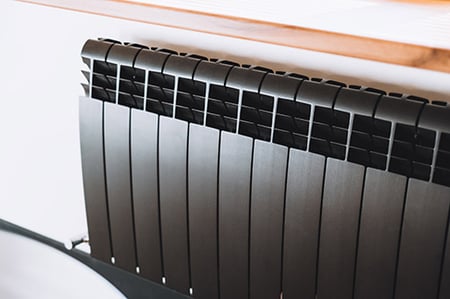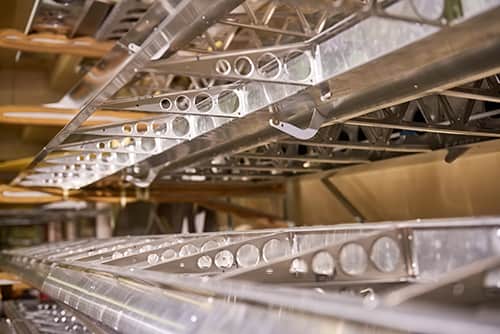Intro
As an engineer, you probably understand how important material selection is. Our team noticed that there’s a lot of confusion when it comes to aluminum alloys. In this guide, we’ll put together a quick cheat sheet to tell you all about aluminum — we’ll cover the grades, uses, and qualities of these different alloys.
What the Grade Means
The “grade” is the four-digit prefix to the aluminum alloy. One of the most common is 6061, so let’s use it as an example.
The first digit tells you what the aluminum is alloyed with. In this example, “6” means it was alloyed with magnesium and silicon.
The second digit tells you if the alloy has any special modifications. “0” means no, so it’s standard.
The third and fourth digits just tell you the variation and percentage of alloyed materials. It doesn’t necessarily mean that there is 6% of one material and 1% of the other.
In general, you’ll notice 8 major families of aluminum alloys. Those are the 8 that we’ll cover in detail now.
1000 Series – “Pure” Aluminum
First up is the family of aluminum that can be upwards of 99% pure aluminum. As a material, it’s weak but highly workable and machinable. It also has good corrosion resistance, and it’s resistant to electricity and magnetism.
When it’s used: You’ll see a 1000 series aluminum used for welding, forming, and spinning.
Where it’s used: Our customers in the chemical, electrical, and food processing/ packaging industries tend to use 1000 aluminums.
2000 Series – Copper Alloys
With a copper-aluminum alloy, heat treating can work wonders. This metal can achieve a strength and hardness that’s close to steel. They’re easy to machine and offer a good strength-to-weight ratio.
When it’s used: Typically used for machining.
Where it’s used: Since it’s strong and lightweight, the aerospace and defense industries choose 2000 series aluminum.

3000 Series – Manganese Alloys
A 3000 series aluminum is a more generally used alloy. They have moderate strength, corrosion resistance, and workability. In fact, 3003 aluminum is one of the most popular options across the board.
When it’s used: For welded, sheet metal, and machined units that need to be aesthetically pleasing.
Where it’s used: Typically used in consumer items like signs, utensils, roofing, guttering, and storage units.
4000 Series – Silicon Alloys
With the addition of silicon, this alloy melts at a lower temperature while keeping most of the mechanical properties of typical aluminum. This makes 4000 aluminum alloys corrosion resistant, thermally conductive, and great for electrical applications.
When it’s used: Our customers request 4000 aluminum alloys for machined and welded parts.
Where it’s used: It’s a common choice for welding wire, and it works well in electrical and automotive applications.
5000 Series – Magnesium Alloys
Adding magnesium to aluminum makes an alloy that’s incredibly corrosion-resistant. It also has a high strength, and the material is easy to machine and weld. Like other aluminum alloys, it’s lightweight.
When it’s used: 5036 is another common welding wire, but the material is often used when corrosion resistance is needed in tough environments.
Where it’s used: We’ve had customers use 5000 series aluminum alloys in their marine, storage, and pressure chamber applications.
6000 Series – Magnesium and Silicon Alloys
A 6000 series aluminum is a mixture of 5000 and 4000 series alloys. As such, you’ll see a lot of combinations between the three series. In our experience, it’s one of the most common options, with 6061 being the frontrunner. The material is a good general-purpose option since it’s strong, lightweight, corrosion-resistant, and easy to work with.
When it’s used: It’s often used in machining, assembling, and welding. You’ll also find some structural options made out of 6000 series aluminums like I-beams and large plates.
Where it’s used: In general applications, throughout the automotive, manufacturing, construction, industrial, and architectural industries (plus many more)
7000 Series – Zinc Alloys
7000 series aluminum alloys are stronger than some types of steel, and they’re the strongest option on this list. The addition of zinc leads to a very hard, strong material that can absorb a lot of stress. They are harder to work on, but that’s due to the added strength.
When it’s used: This alloy is typically reserved for high-strength applications where minimizing weight is important.
Where it’s used: You’ll find 7000 series aluminums used in the automotive, defense, and aerospace sectors.
8000 Series – Other Alloy Categories
The final category is a catchall for specialty aluminum alloys. You’ll usually see options in here that were hand-crafted for specific applications in certain companies. If a company requires a certain combination of material properties, the option will likely be found within the 8000 series.
When it’s used: When an application has a specific need that can’t be met by other options.
Where it’s used: Any industry can use 8000 series aluminum, but it’s often used in chemical, defense, aerospace, and industrial settings.
Conclusion
We just covered some of the biggest alloys of aluminums, as well as their use and when you might encounter them. If you need help picking the right material choice for your next project, reach out to our experts at Rapid Axis. We have the expertise to help you through your project, and we have the tools to deliver exceptional results.


